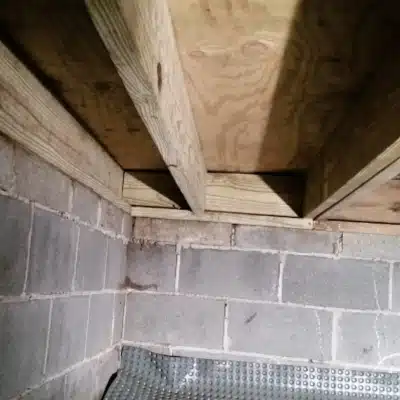Sagging Floors
Your home depends on its foundation for structural support. Any damage to the foundation causes problems for walls and floors. Sagging floors are a symptom of foundation damage. Here’s what you should know.

Sagging Floor Foundation Repair in Northern Virginia, Shenandoah Valley, North Central Virginia, and West Virginia
Sagging floors often happen in homes with a crawl space foundation. Moisture buildup in the crawl space can cause the floor joists (which support your home’s floors) to weaken over time. Eventually, your floors will sag or flex and may even separate from the floorboards.
They are not only unsightly but also potentially dangerous. They indicate a loss of support and could lead to a collapse into lower levels of your home. This poses a significant risk to the overall structure of your home, making repairs a top priority.
LUX Foundation Solutions’ trained professionals have the necessary tools to repair sagging floors and prevent future problems. With LUX’s team of foundation repair experts backed by engineered products, you can trust that our solutions will keep your sagging floors level and even for years to come.
Do These Signs of Sagging Floors Seem Familiar?
The symptoms
Are your floors showing signs of sagging? Don’t ignore these alarming indicators, as they could be a sign of underlying foundation problems. Sagging floors can manifest in various ways, such as:
- Bouncy or springy areas
- Visible cracks on the floor’s surface
- Uneven or sloping floors
- Cracks in walls or ceilings
- Difficulty opening or closing doors and windows
- Gaps between walls and floors or ceilings
If you’ve noticed these signs in your home or property, it’s crucial to take immediate action to prevent further damage and ensure the safety of your home’s structure.
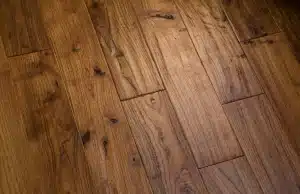
Bouncy floors

Visible cracks in floors

Uneven or sloping floors

Cracks in walls
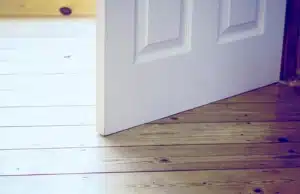
Difficulty in opening doors
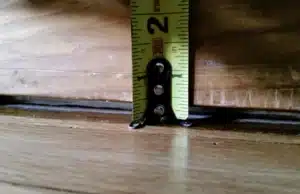
Gap between floor and wall
What Causes Sagging Floors?
Sagging floors happen when there is too much moisture in your crawl space. Sometimes, mistakes made during construction can cause it, too. Here, we’ll tell you about the main reasons for this problem.
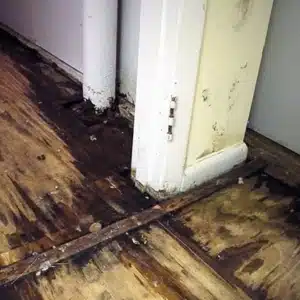
Moisture Damage
Moisture can weaken the wooden supports that hold up your home’s flooring, making them sag or bend over time. Prolonged exposure to excess moisture in water leaks, high humidity, or poor drainage can lead to moisture damage. This damage can affect wooden support beams, joists, or concrete foundations.
Additionally, it can corrode steel or deteriorate concrete, compromising its structural integrity. As these structural elements weaken, they may no longer adequately support the floor, resulting in sagging or unevenness.
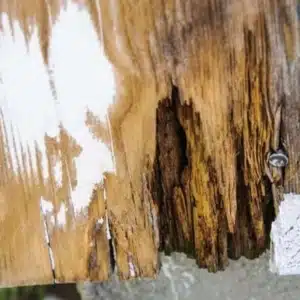
Aging
Homes will experience natural wear and tear over time, as with any structure. As the wood supports under your home’s flooring begin to age, they can weaken and cause the floors to sag or bend. This is especially common in older homes that have not had regular maintenance or repairs over time.

Poor structural design
Inadequate structural design during construction or renovations in your home can lead to sagging floors. This may involve insufficient support beams, joists, or inadequate spacing between them. Over time, the excessive load placed on the floor can cause it to sag.
To address this, homeowners may need to consult with a structural engineer to assess the design and potentially reinforce the structural elements to support the floor properly.
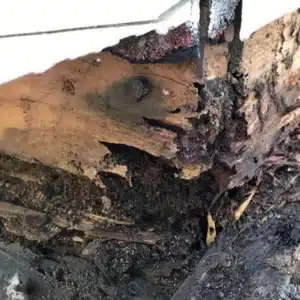
Wood Rot
Wood is a common material used in floor joists and support beams. When wood is exposed to moisture over an extended period, it can begin to rot. Rotting wood loses its strength, leading to sagging floors.
To prevent wood rot, it’s crucial to address any water leaks or moisture issues in the basement or crawl space. Additionally, regular inspections and timely replacement of deteriorated wood components can help maintain the floor’s structural integrity.
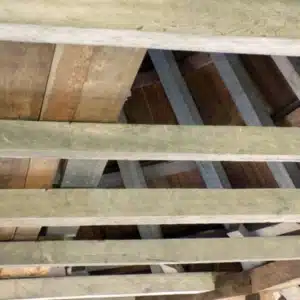
Over Spanned Floor Joists
Over-spanning occurs when the distance between support points for the floor joists exceeds the load-bearing capacity of the joists. If the floor joists in your home are too far apart, it can result in sagging or deflection of the floor between support beams, leading to an uneven or weakened floor.
Proper structural design and adherence to building codes are crucial to prevent over-spanning.

Settling or Shifting Soil Beneath the Foundation
If the soil beneath your home is unstable or shifting, it can also cause your foundation to settle or shift. As a result, the floor joists may no longer be properly supported, leading to sagging or uneven floors. Proper foundation support and periodic inspections are essential to address settling or shifting soil.
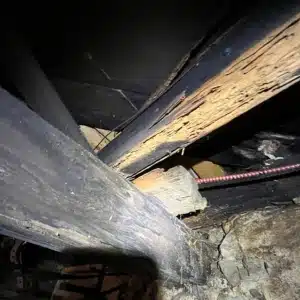
Inadequate or Deteriorating Support Beams
The support beams in your home are responsible for holding up the weight of your entire house. They play a crucial role in distributing the load from the floor joists to the foundation.
If these beams are inadequately sized, spaced too far apart, or if they deteriorate over time, they may not provide sufficient support to the floor joists. This can result in sagging or uneven floors.

Weakened Floor Joists
Floor joists can weaken due to various factors, such as prolonged exposure to moisture, wood rot, or pest infestations. Weakened joists lose their load-bearing capacity and may deflect under the weight of the floor and occupants.
This can lead to noticeable floor sagging. Identifying the cause of joist weakening and addressing it through repairs or replacements is essential to ensure a stable and level floor.
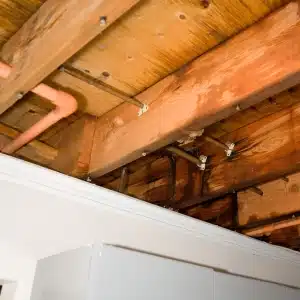
Water Damage Due to Plumbing Leaks or Improper Drainage
Water damage resulting from plumbing leaks, poor drainage, or inadequate waterproofing in your house can compromise the structural integrity of support beams and floor joists underneath.
Moisture exposure can lead to rotting of wooden joists, corrosion of metal components, or deterioration of concrete supports. As these structural elements weaken, the floor can sag or become uneven. It’s crucial to promptly address water-related issues and ensure proper drainage and waterproofing to prevent further damage.

Pest Damage
Pests, such as termites, carpenter ants, or wood-boring beetles, can cause significant damage to your home’s wooden structural elements, including floor joists. These pests typically feed on the cellulose in wood, weakening the joists’ structural integrity over time.
As the wood is consumed and weakened, the joists may lose their load-bearing capacity, resulting in sagging or uneven floors and no longer providing adequate support for your home.
To accurately determine the root cause of your sagging floors, you should schedule a free inspection by our experienced team at LUX Foundation Solutions.
Our Solutions
To deal with sagging floors in your house caused by foundation sinking, the recommended solution is to implement supplement beams support. Supplement beams are additional structural elements installed beneath the sagging floors to provide additional support and redistribute the structure’s weight. This helps to alleviate the stress on the existing foundation and restore the level of the floors. The process involves assessing the extent of the sagging, designing the supplemental beam system, and professionally installing the beams to ensure proper structural reinforcement.
It is advisable to consult with a trusted foundation repair company like LUX Foundation Solutions to assess the situation and determine the appropriate supplemental beam support required for your specific case.
To stop floor joists from sagging or bouncing, the LUX Foundation Solutions recommends using their floor joist stabilizer. This method involves installing steel support beams beneath the floor joists to prevent sagging, minimize bounce, and increase rigidity, thus reducing any unwanted movement.
The stabilizer is designed to distribute the weight load evenly, preventing stress from being concentrated in one area. This solution effectively solves the issue of sagging or bouncing floor joists, providing a stable and level foundation for your home.
Yes, it may be necessary to replace damaged floor joists depending on the severity of the damage and the level of structural support required. If the damage is minor, floor joist sistering may be a viable solution. Floor joist sistering involves attaching new joists to the existing joists to reinforce and strengthen the damaged ones.
However, if the damage is severe and the floor’s structural integrity is compromised, replacement may be necessary. This involves removing the damaged joists and replacing them with new ones to support the floor properly. It’s essential to consult with a professional foundation repair service like the LUX Foundation Solutions team to determine the best solution for your specific situation.
Free Sagging Floors Repair Estimates in Northern Virginia, Shenandoah Valley, North Central Virginia, and West Virginia
If you’re experiencing sagging floors, it doesn’t get better with time, so don’t wait until the problem worsens. Schedule a free estimate with LUX Foundation Solutions today.
LUX Foundation Solutions has the expertise and state-of-the-art products to diagnose and provide sagging floor foundation repair solutions. Our team of professionals will assess the condition of your foundation, identify the root cause of the floor issues, and provide a customized plan of action.
Don’t compromise the safety and stability of your home — contact us at 540-508-8587 or fill out our online estimate request form to schedule an on-site foundation estimate and expert advice to get your home back on solid ground. We proudly serve foundation repair services in Northern Virginia, Shenandoah Valley, North Central Virginia, West Virginia, and surrounding areas.
Request a free Estimate
FAQ's
Sagging floors can indeed be an indication of underlying foundation problems, but other factors can also cause them. Foundation settlement, shifting soil, or weakened support beams are common causes of uneven floors. However, it’s essential to consider other factors, such as poor construction, aging materials, pest infestations such as termites, or water damage, that can also contribute to this issue.
To accurately determine the cause, it is advisable to consult a professional structural engineer or foundation specialist who can assess your specific situation and provide appropriate recommendations for repair or mitigation.
Sagging floors can be a common issue in old homes and can be caused due to a variety of reasons. However, one of the major reasons can be a foundation issue. To determine if the sagging floors in your house result from a foundation issue, you need to look for the following symptoms: cracks in the walls or ceiling, sloping floors, windows or doors that stick, and gaps around the doors or windows.
These symptoms can clearly indicate a foundation issue and should not be ignored. Consulting a professional foundation repair company can help you determine the exact cause of the problem and provide appropriate solutions.
Ignoring or neglecting sagging floors caused by a foundation problem can result in serious consequences that can put the safety of occupants at risk. These consequences include cracked walls, jammed doors and windows, and twisted and weakened structural frames. Moreover, the sagging floors can create tripping hazards that can cause severe injuries to family members or visitors. Over time, this can also lead to worsening structural damage that can be time-consuming and costly.
Therefore, it is crucial to address any sagging floor issues as soon as they are noticed to prevent serious consequences and ensure the safety of your home’s occupants.
If your home’s floors are sagging, attempting to fix the issue on your own may be tempting. However, it is essential to understand that properly addressing this problem requires a level of expertise that most homeowners do not possess. Without fully understanding the underlying cause of the issue, attempting a DIY repair could actually make the problem worse. It is always best to seek the assistance of a trusted foundation repair service to properly diagnose and address the root cause of sagging or flexing floors in your home. Doing so can help ensure that the problem is resolved effectively and that your home is safe and structurally sound for years to come.

